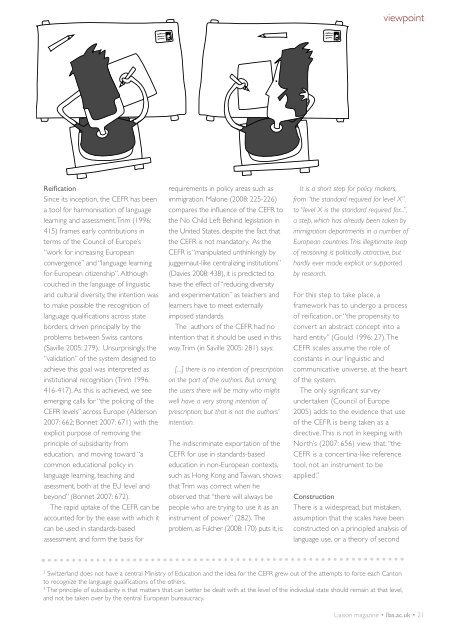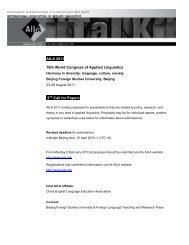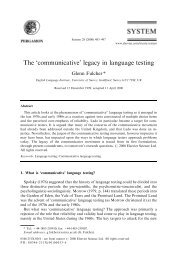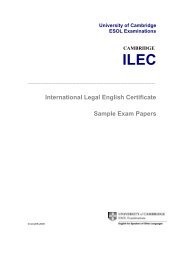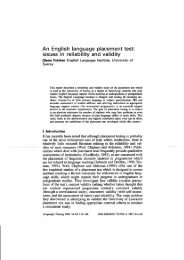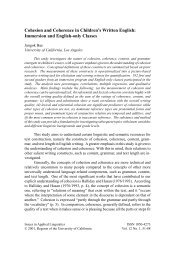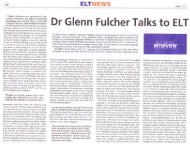Liaison Magazine - LLAS Centre for Languages, Linguistics and ...
Liaison Magazine - LLAS Centre for Languages, Linguistics and ...
Liaison Magazine - LLAS Centre for Languages, Linguistics and ...
You also want an ePaper? Increase the reach of your titles
YUMPU automatically turns print PDFs into web optimized ePapers that Google loves.
viewpoint<br />
Reification<br />
Since its inception, the CEFR has been<br />
a tool <strong>for</strong> harmonisation of language<br />
learning <strong>and</strong> assessment.Trim (1996:<br />
415) frames early contributions in<br />
terms of the Council of Europe’s<br />
“work <strong>for</strong> increasing European<br />
convergence” <strong>and</strong> “language learning<br />
<strong>for</strong> European citizenship”. Although<br />
couched in the language of linguistic<br />
<strong>and</strong> cultural diversity, the intention was<br />
to make possible the recognition of<br />
language qualifications across state<br />
borders, driven principally by the<br />
problems between Swiss cantons<br />
(Saville 2005: 279). Unsurprisingly, the<br />
“validation” of the system designed to<br />
achieve this goal was interpreted as<br />
institutional recognition (Trim 1996:<br />
416-417). As this is achieved, we see<br />
emerging calls <strong>for</strong> “the policing of the<br />
CEFR levels” across Europe (Alderson<br />
2007: 662; Bonnet 2007: 671) with the<br />
explicit purpose of removing the<br />
principle of subsidiarity from<br />
education, <strong>and</strong> moving toward “a<br />
common educational policy in<br />
language learning, teaching <strong>and</strong><br />
asessment, both at the EU level <strong>and</strong><br />
beyond” (Bonnet 2007: 672).<br />
The rapid uptake of the CEFR can be<br />
accounted <strong>for</strong> by the ease with which it<br />
can be used in st<strong>and</strong>ards-based<br />
assessment, <strong>and</strong> <strong>for</strong>m the basis <strong>for</strong><br />
requirements in policy areas such as<br />
immigration. Malone (2008: 225-226)<br />
compares the influence of the CEFR to<br />
the No Child Left Behind legislation in<br />
the United States, despite the fact that<br />
the CEFR is not m<strong>and</strong>atory. As the<br />
CEFR is “manipulated unthinkingly by<br />
juggernaut-like centralizing institutions”<br />
(Davies 2008: 438), it is predicted to<br />
have the effect of “reducing diversity<br />
<strong>and</strong> experimentation” as teachers <strong>and</strong><br />
learners have to meet externally<br />
imposed st<strong>and</strong>ards.<br />
The authors of the CEFR had no<br />
intention that it should be used in this<br />
way.Trim (in Saville 2005: 281) says:<br />
[...] there is no intention of prescription<br />
on the part of the authors. But among<br />
the users there will be many who might<br />
well have a very strong intention of<br />
prescription; but that is not the authors’<br />
intention.<br />
The indiscriminate exportation of the<br />
CEFR <strong>for</strong> use in st<strong>and</strong>ards-based<br />
education in non-European contexts,<br />
such as Hong Kong <strong>and</strong> Taiwan, shows<br />
that Trim was correct when he<br />
observed that “there will always be<br />
people who are trying to use it as an<br />
instrument of power” (282). The<br />
problem, as Fulcher (2008: 170) puts it, is:<br />
It is a short step <strong>for</strong> policy makers,<br />
from “the st<strong>and</strong>ard required <strong>for</strong> level X”<br />
to “level X is the st<strong>and</strong>ard required <strong>for</strong>...”,<br />
a step, which has already been taken by<br />
immigration departments in a number of<br />
European countries.This illegitimate leap<br />
of reasoning is politically attractive, but<br />
hardly ever made explicit or supported<br />
by research.<br />
For this step to take place, a<br />
framework has to undergo a process<br />
of reification, or “the propensity to<br />
convert an abstract concept into a<br />
hard entity” (Gould 1996: 27).The<br />
CEFR scales assume the role of<br />
constants in our linguistic <strong>and</strong><br />
communicative universe, at the heart<br />
of the system.<br />
The only significant survey<br />
undertaken (Council of Europe<br />
2005) adds to the evidence that use<br />
of the CEFR is being taken as a<br />
directive.This is not in keeping with<br />
North’s (2007: 656) view that:“the<br />
CEFR is a concertina-like reference<br />
tool, not an instrument to be<br />
applied.”<br />
Construction<br />
There is a widespread, but mistaken,<br />
assumption that the scales have been<br />
constructed on a principled analysis of<br />
language use, or a theory of second<br />
2<br />
Switzerl<strong>and</strong> does not have a central Ministry of Education <strong>and</strong> the idea <strong>for</strong> the CEFR grew out of the attempts to <strong>for</strong>ce each Canton<br />
to recognize the language qualifications of the others.<br />
3<br />
The principle of subsidiarity is that matters that can better be dealt with at the level of the individual state should remain at that level,<br />
<strong>and</strong> not be taken over by the central European bureaucracy.<br />
<strong>Liaison</strong> magazine • llas.ac.uk •21


